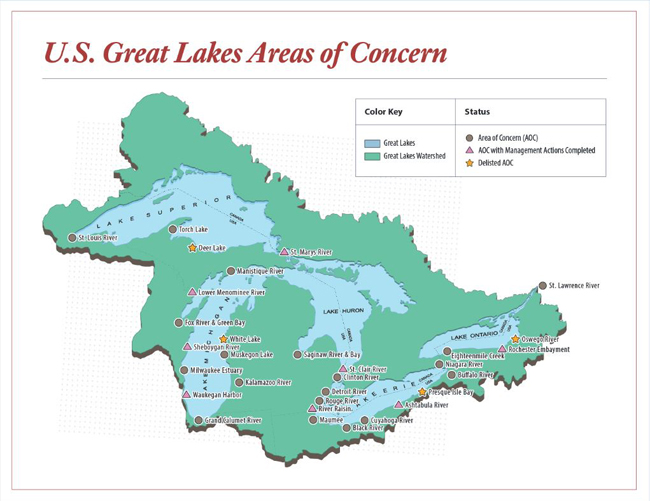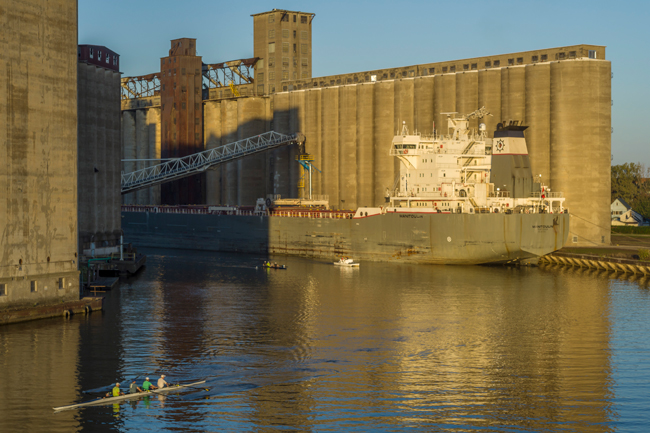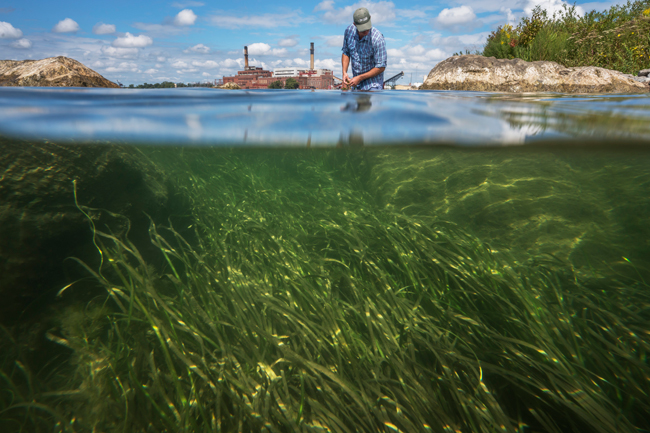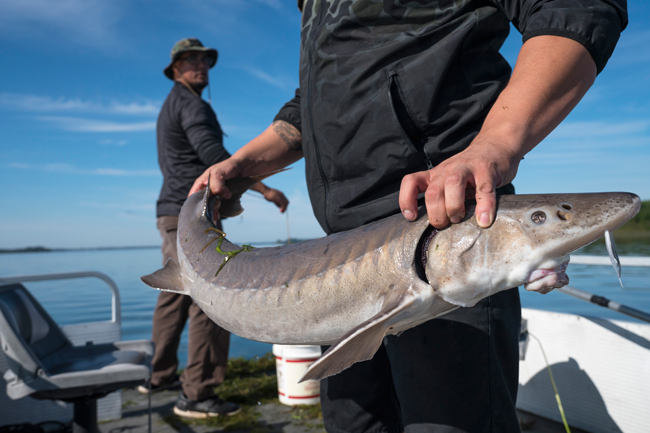
In 1987, the Great Lakes Water Quality Agreement designated 31 Areas of Concern (AOC) in the United States. AOCs are Great Lakes tributaries with significant pollution and habitat problems.
Buffalo, NY, September 9, 2019 - For decades, whether manufacturing oil, steel, cars, heavy machinery, or more, communities along the Great Lakes and nearby waterways thrived economically, helping to build the region and the country.
When much of the industry moved to other parts of the world, waterways were left with a legacy of pollution. And the communities that sit on their shores had to cope with environmental, health, and economic setbacks.
This sets the stage for "Great Lakes Resurgence: Clean-up Efforts Bring Life to Local Waterfronts," a visually-driven Web story compiled by the various Great Lakes Sea Grant programs, which includes New York Sea Grant.
Fueled by the work of National Geographic photographer Peter Essick, this photo essay sheds some light on a number of the Areas of Concern (AOC) in the Great Lakes, whose waters border eight U.S. states: New York, Pennsylvania, Ohio, Illinois, Indiana, Michigan, Minnesota, and Wisconsin. On the international side, these five lakes border Ontario, a providence in Canada.
A great deal of the value of Lakes Superior, Huron, Michigan, Erie and Ontario lies in the fact that combined they make up the largest body of fresh water on Earth, accounting for one-fifth of the freshwater surface on the planet at 6 quadrillion gallons.
Several tributaries of Lake Ontario are highlighted in this project by New York Sea Grant. Those include ...
The Buffalo River

People recreating on the Buffalo River, backdropped by grain silos, which really made Buffalo the “Queen City” of the Great Lakes. Credit (for this and all images below): Peter Essick.
On any given fair weather day, you'll find people kayaking, fishing or enjoying the Buffalo River, which is back-dropped by grain silos that once made Buffalo, NY the “Queen City” of the Great Lakes. While much of that shoreline industry has withered, its impacts have not.
Designated an AOC under the 1987 Great Lakes Water Quality Agreement, the Buffalo River has received its share of contaminants, from PCBs and PAHs to heavy metals and industrial organics. These have led to restrictions on consumption of as well as degradation and loss of fish and wildlife. Additionally, dissolved oxygen levels, turbidity and bacterial contamination all pose water quality concerns.
But through several decades of remediation efforts coordinated by the Buffalo Niagara Waterkeeper, the river has been going through a transformation that is playing a large part in Buffalo's "blue economy." Approximately one million cubic yards of contaminated sediment, enough to fill a football field 40 stories high, has been dredged from the river. The river's bottom habitat also got a boost with the installation of clean sediment, plants, and fish habitat structures. The transformation has helped the river become a beneficial environmental, economic, and community resource.
Restoration projects such as these, supported with $48.5 million in Great Lakes Restoration funds, have included partners such as U.S. Environmental Protection Agency's Great Lakes National Program Office, the NYS Department of Environmental Conservation, the U.S. Army Corps of Engineers and the New York and Illinois-Indiana Sea Grant programs.
Niagara River

On the Niagara River, a 37-mile binational strait connecting lakes Erie and Ontario, local advocacy groups like Buffalo Niagara Waterkeeper have devoted over $100 million combined for habitat projects such as eel grass restoration. These efforts are shadowed by structures like the Huntley Power Plant, an example of the type of industry that still lines the river and has contributed to its legacy contamination.
Development and industry in the past several hundred years have severely altered the habitat and water quality in the Niagara River, which is also a 1987 AOC designee. This long history of development, contaminated discharge and sediments as well as proximity to hazardous and Superfund sites has led to habitat degradation and challenges to the survival of aquatic life.

On the plus side, Waterkeeper monitors water quality at 10 locations along the Niagara River and organizes shoreline cleanups along the river several times each year.

In addition to the Niagara and Buffalo Rivers, three other AOCs are located along Lake Ontario: Rochester Embayment, Eighteen Mile Creek and St. Lawrence River, where the Saint Regis Mohawk tribe (pictured above) plays a pivotal role in local stewardship.
The Oswego River, which was once named an AOC, reached its delisting targets in 2006. However, monitoring continues to this day.

Lake sturgeon are listed by the New York State Department of Environmental Conservation as a Species of Greatest Conservation Need, and considered a priority species for recovery in New York. Today, it is illegal to possess lake sturgeon or target them while fishing in New York. In March, New York Sea Grant received funding from the Disney Conservation Fund for its work to support lake sturgeon recovery efforts in New York and lead outreach and education programs to inspire appreciation for this prehistoric freshwater fish and state Threatened Species.
More Info: New York Sea Grant
New York Sea Grant (NYSG), a cooperative program of Cornell University
and the State University of New York (SUNY), is one of 33 university-based
programs under the National Oceanic and Atmospheric Administration’s
National Sea Grant College Program.
Since 1971, NYSG has represented a statewide network of integrated
research, education and extension services promoting coastal community
economic vitality, environmental sustainability and citizen awareness
and understanding about the State’s marine and Great Lakes resources.
Through NYSG’s efforts, the combined talents of university scientists
and extension specialists help develop and transfer science-based
information to many coastal user groups—businesses and industries,
federal, state and local government decision-makers and agency managers,
educators, the media and the interested public.
The program maintains Great Lakes offices at Cornell University, SUNY
Buffalo, SUNY Oswego and the Wayne County Cooperative Extension office
in Newark. In the State's marine waters, NYSG has offices at Stony Brook
University in Long Island, Brooklyn College and Cornell Cooperative
Extension in NYC and Kingston in the Hudson Valley.
For updates on Sea Grant activities: www.nyseagrant.org has RSS, Facebook, Twitter, and YouTube links. NYSG offers a free e-list sign up via www.nyseagrant.org/nycoastlines for its flagship publication, NY Coastlines/Currents, which is published quarterly. Our program also produces an occasional e-newsletter,"NOAA Sea Grant's Social Media Review," via its blog, www.nyseagrant.org/blog.